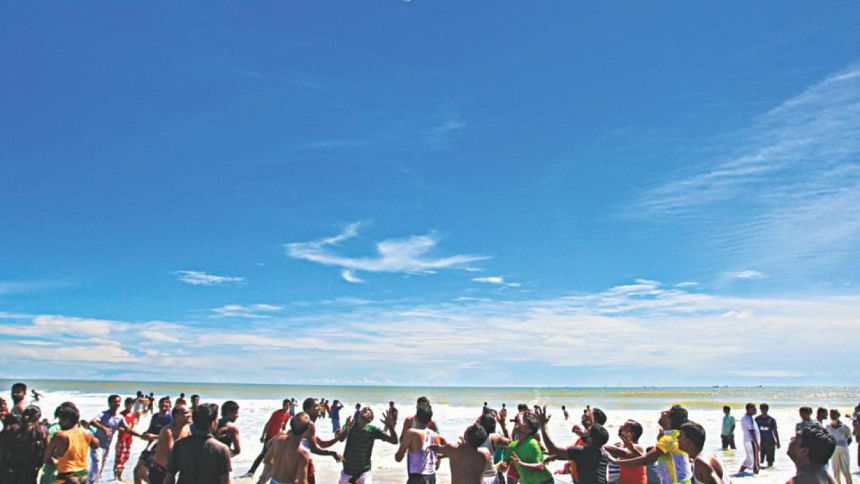Bangladesh's beauty spots and how not to destroy them

I was in Bandarban towards the end of this April. An extended holiday weekend had just begun, with fatigued tourists crossing hundreds of miles from around the country to reach this dreamy south-eastern district of Bangladesh. Bandarban, with its remote tribal villages, many still cut off from the outside world, its mountains and springs, blissfully simple life, and the beautiful Sangu with its rocky riverbed, rapids and boulders, is like a Mecca for both nature-lovers and adventure-seekers. It's the kind of place you never tire of getting back to, like a beautiful dream from your childhood that you relive even long after you have reached adulthood or passed into decrepitude, and the memory of it is so precious that you feel almost protective of it.
The first time I came to Bandarban was nearly a decade ago. Along with three others, I scaled what was then considered the highest peak in Bangladesh. Bandarban was not a popular destination then. There were fewer tourists, and fewer assaults on the integrity of the place. In a few years this would change. There are now more visitors than I ever imagined a place as restricted as this would accommodate. In Thanchi, the familiar calm has been replaced by chaos. There are, of course, more structures and roads that came through the promised path of development, but there is also considerably more garbage, with cigarette butts, discarded packets and water bottles strewn across the dirt tracks. As we waded in the deep, the air smacked of self-indulgence. Judging by the rapidity with which trash is accumulating, it may not be long before those beautiful waterfalls will turn into sinkholes of plastic waste.
All this goes to show, to rephrase Buddhist monk Thich Nhat Hanh, how travelling without knowing how to travel hurts the place we travel to.
In recent years, Bangladesh has witnessed a remarkable boom in its domestic tourism sector. Tourism is the subject of increasing policy attention which can be understood from the fact that Tk 1,508 crore has been allocated for the Civil Aviation and Tourism Ministry in the proposed budget for FY2018-19, a solid Tk 821 crore increase over the previous year's proposed budget. Bangladesh, for what it's worth, has also been elected as the chairperson of the Islamic Conference of Tourism Ministers (ICTM) for the term 2018-19 while Dhaka, its capital, declared the OIC City of Tourism for 2019. Although inbound tourism remains stagnant, local tourists are more than making up for it.
How much of this growth is sustainable remains a question however. Take Cox's Bazar, the jewel in the crown of Bangladesh tourism. In 2012, the BBC published a report entitled "Bangladesh's Cox's Bazar: A paradise being lost?" in which it showed how mass tourism and unplanned development were putting Cox's Bazar at risk. Six years down the line, that blissful, breezy paradise is now in a shambles. A cursory visit to any other tourist spot might reveal a more or less similar scene of mayhem and pollution. We have managed to bring Sundarbans to its knees, exhaust Rangamati, and leave a toxic legacy of waste in St Martin's Island. All in the name of tourism and development.
Can mass tourism ever be sustainable? Here lies a paradox. Part of Bandarban's old-world charm, for example, is its remoteness and lack of access to what in cities we take for granted. But mass tourism demands that there will be greater connectivity and greater access to essentials/amenities. You need to boost tourism through the provision of all these facilities but at the same time, you need to exercise restraint to preserve the integrity of the place, local culture and the environment. But can an industry built on self-indulgence and escapism integrate restraint in any real way?
How we respond to this issue will affect the trajectory of our tourism in the coming days. Some people, however, say tourism is inherently unsustainable, because travel addiction is itself unsustainable. This is apparent in the new breed of litter-dropping, camera-brandishing tourists emerging out of Bangladesh's latest crush with "exotic" destinations. In many ways, they resemble one described in a satirical piece by The Onion that I read some time ago. It talks about an American girl whose six-day visit to a "dusty, remote town" in Africa completely changed her life—nay, her profile picture. "I don't think my profile photo will ever be the same, not after the experience of taking such incredible pictures with my arms around those small African children's shoulders," the 22-year-old girl said. "Honestly, I can't even imagine going back to my old Facebook photo of my roommate and I at an outdoor concert!"
One can link this tendency to reduce a place's worth to a shareable photo, or the failure to form a real connection with a place or grasp anything beyond the superficial, to a lack of respect for that place and those who inhabit it.
In the sustainable tourism discourse, there is a difference between an actual bond and a forced relatedness. The first you establish through a sincere willingness to understand, connect, and reciprocate—you respect local people, respect their way of life, and behave responsibly. The second, real as it may seem, is nothing but a shadow of the former. It's like ventriloquising someone who isn't there. You talk yet you don't connect, you see yet you don't understand, you listen yet so much of what's being said remains unaccounted for. You reach out yet all you seem to achieve is a momentary, self-gratifying relatedness. Unfortunately, what's happening in Bangladesh's tourism sector is a celebration of forced relatedness, and given the enormous risks that it poses, it makes it that much important that we talk about forming mutually-enriching bonds. It's important that we talk about achieving that bond through sustainable tourism.
In recent times, there's been much discussion about how to advance this sustainability, particularly in light of a global campaign called "Travel.Enjoy.Respect" launched by the UN World Tourism Organization (UNWTO) last year. Bangladesh can learn from the best practices of advanced destination countries. Already in Europe, authorities in a number of destinations have proposed—or put in place—policies restricting the annual number of trips and tourists to mitigate the effects of mass tourism. According to a report by The Telegraph, 2017 has witnessed a "sharp rise" in anti-tourist sentiment throughout Europe.
We may not yet have a situation in which we will have to consider drastic measures to cap visitors but it would be unwise to lose sight of the fact that some degree of anti-tourist sentiment is already there in some parts of Bangladesh because of irresponsible travel behaviour, despite the economic boost that tourists give to the host communities. As we begin another fiscal year, this and other issues will hopefully be taken into account and followed up with judicious policy interventions for the reforms that are needed. Bangladesh may feel like it has been saddled with cleaning an industry well before it reached maturity, and the road to sustainability may be long and complicated, but as conventional wisdom suggests, a slow, sustainable growth is better than an unchecked and undisciplined one. Preservation—and even betterment—of our tourist destinations is in our own best interest.
Badiuzzaman Bay is a member of the editorial team at The Daily Star.
Email: [email protected]





Comments